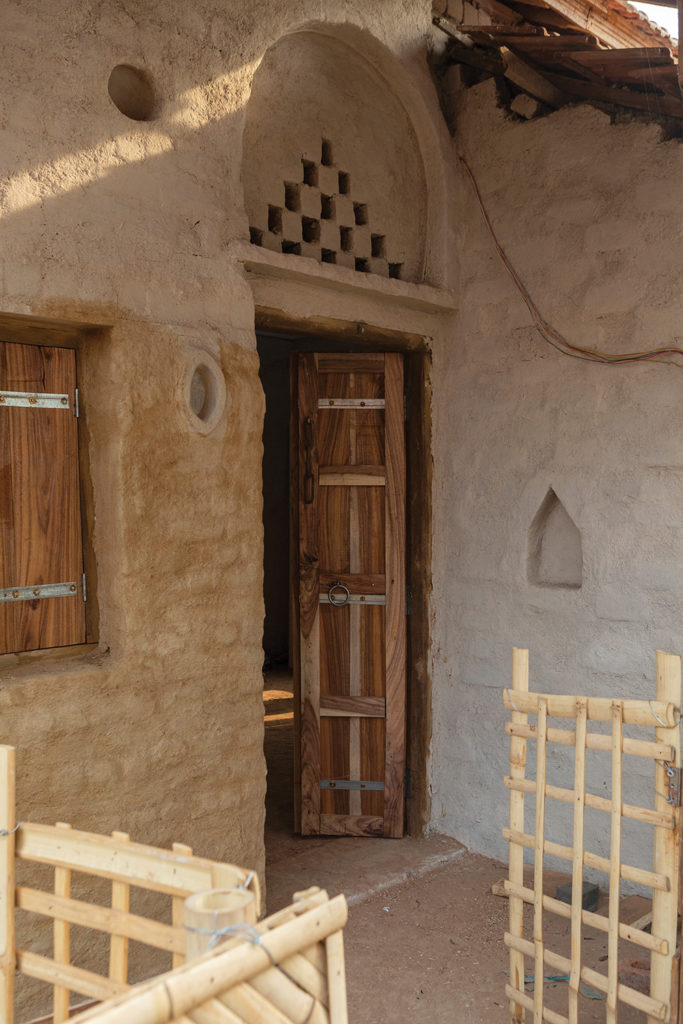Writer’s Note: Creating Spaces for Animals
September 20, 2023

My own childhood, growing up in Hardoi, a small town in Uttar Pradesh, has exposed me to Nature and its brilliant beings. We played in mango orchards full of monkeys and among the chirping of birds. Every evening, cows, dogs and cats visited our door and my mother gave them wheat chapatis.
The most vivid memory of that time was of the clay pot that my grandfather hung at our balcony for the birds. It had two chambers, one for water and one for grains. It was frequented by many sparrows, pigeons, mynas, etc., over the course of a day, singing and chirping almost in rhythm. Every morning he refilled it without fail.
For the last eight years, I have been photographing the giant birdhouses of South Asia, especially in the Kutch district of Gujarat. This came about while exploring Bhuj, another small town in the heart of Kutch district, I stumbled upon a beautiful structure with a column supporting almost a sculptural top with hundreds of little door-like holes decorated with ornamentation. It was like an abstraction of a giant tree with a more geometric form. Soon a pigeon peeped out of one of the ‘doors’. In no time there were hundreds of birds flying in and out of that grand birdhouse. Locals told me it is called ‘chabutra’.
Over the time of my stay and constant visits to Kutch, I started photo-documenting, collecting local narratives and people’s memories associated with the beautifully crafted birdhouses5. This journey has led me to go deeper into exploring the architectural dynamics between humans and non-human species.
RELATED: Designing for Non-humans as an Act of Service
In my personal design practice, I prioritise creating spaces for animals whenever possible. I would like to share two examples that highlight my approach.
The first example revolves around a cat house I designed and built for a street cat named Noori. To construct the cat house, I utilised earthen cups that I collected after my daily cup of chai from the streets, which would otherwise be discarded. By saving these cups, I managed to gather half of the materials needed for Noori’s house. To acquire the remaining cups, I purchased them from a local potter. Organising a workshop, I invited my fellow designer friends to join me in constructing a vault-like structure using the earthen cups. We built a series of arches, progressively increasing their height to create a shelter-like feel within the cat house.


Noori greatly enjoyed the space, and since it was made of terracotta, the temperature inside remains regulated. On hindsight, I realised that using plaster of Paris (POP) to join the gaps between the arches was not the best choice in terms of water resistance. Using clay would have been more appropriate and sustainable.
The second example stems from a homestay project undertaken by our collective, Dhammada. We have been involved in designing homestays in various villages across Madhya Pradesh, where we prioritise using local materials and traditional building techniques. In one particular house, I instructed the masons to incorporate an earthen pot above the door frame during the wall construction. This earthen pot serves as a nesting spot for birds, allowing them to build their nests in a safe and protected environment.
By integrating these animal-friendly features into our designs, we aim to create spaces that coexist harmoniously with the natural world while enhancing the well-being of both humans and animals.
[This is an excerpt. Subscribe to the digital edition or hardcopy to read the complete article.]

Nipun Prabhakar is an independent documentary photographer and architect based in India. He works on long-term projects dealing with intersections of ideas, artifacts, the built environment and folklore. His background as an architect has deeply impacted his sense of space in situations that call for a contextual response to culture and geography. His work has been supported by the Aga Khan Trust for Culture, AKDC at MIT, among others. He is a recipient of the Berkeley Essay Prize 2014 and was Cornell University’s South Asian Fellow 2019-20.
Read more stories from FuturArc 3Q 2023 Green Awards: Cross-Generational Architecture!

Bibliography
1 Dobraszczyk, Paul. Animal Architecture: Beasts, Buildings and Us. Reaktion Books, 2023.
2 Christiane Gruber. ‘Like Hearts of Birds: Ottoman Avian Microarchitecture in the Eighteenth Century’. Journal18: A Journal of Eighteenth-Century Art and Culture, Apr. 2021, https://www.journal18.org/issue11/like-hearts-ofbirds-ottoman-avian-microarchitecture-in-the-eighteenthcentury/.
3 Building Collisions Kill Hundreds of Millions of Birds per Year | Audubon. 30 Jan. 2018, https://www.audubon.org/news/building-collisions-kill-hundreds-millions-birds-year.
4 ‘First in Country: A Flyover for Animals on Mumbai-Nagpur Highway’. The Times of India, 23 Feb. 2022. The Economic Times – The Times of India, https://timesofindia.indiatimes.com/city/nagpur/eco-bridges-on-e-way-samruddhi-for-all/articleshow/89757839.cms.
5 Prabhakar, Nipun. ‘Documenting India’s Distinctive Birdhouses’. The New York Times, 27 June 2022. NYTimes.com, https://www.nytimes.com/2022/06/27/travel/birdhouses-kutch-district-india.html.
To read the complete article, get your hardcopy at our online shop/newsstands/major bookstores; subscribe to FuturArc or download the FuturArc App to read the issues.
Previously Published Commentary
Contact us at https://www.futurarc.com/contact-us for older commentaries.

